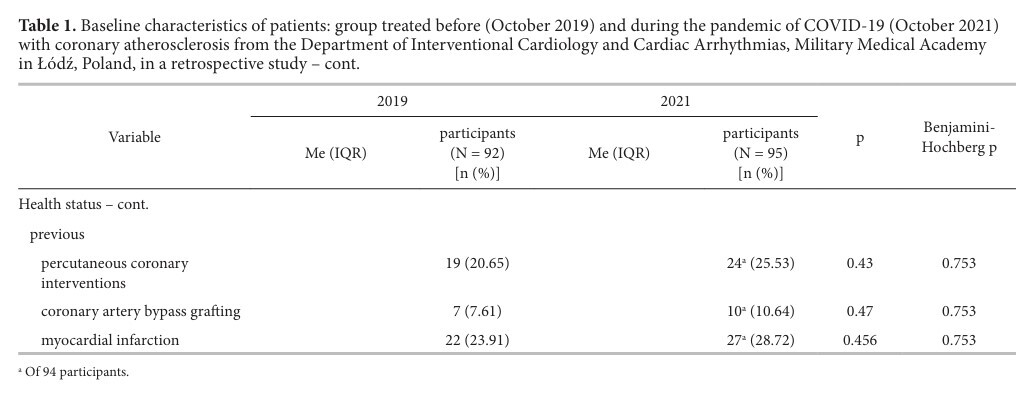Online first
Bieżący numer
Archiwum
Najczęściej cytowane 2024
O czasopiśmie
Zespół Redakcyjny
Komitet Redakcyjny
Polityka prawno-archiwizacyjna
Kup czasopismo
Klauzula informacyjna o przetwarzaniu danych osobowych
Deklaracja dostępności
Instrukcje dla Autorów
Instrukcje dla Recenzentów
Polecamy
Kontakt
Recenzenci
2024
2023
2022
2021
2020
2019
2018
2017
2016
2015
2014
2013
Redakcja i tłumaczenia
PRACA ORYGINALNA
Increased coronary artery disease severity in patients undergoing invasive diagnostics during the COVID-19 pandemic
1
Medical University of Lodz, Łódź, Poland (Department of Interventional Cardiology and Cardiac Arrhythmias, Military Medical Academy, Memorial Teaching Hospital)
2
Medical University of Lodz, Łódź, Poland (Department of Conservative Nursing, Faculty of Health Sciences)
3
Medical University of Lodz, Łódź, Poland (Department of Biostatistics and Translational Medicine)
Data publikacji online: 28-08-2024
Autor do korespondencji
Tomasz Wcisło
Medical University of Lodz, Department of Interventional Cardiology and Cardiac Arrhythmias, Military Medical Academy, Memorial Teaching Hospital, Żeromskiego 113, 90-549 Łódź, Poland
Medical University of Lodz, Department of Interventional Cardiology and Cardiac Arrhythmias, Military Medical Academy, Memorial Teaching Hospital, Żeromskiego 113, 90-549 Łódź, Poland
Med Pr Work Health Saf. 2024;75(4):333-42
SŁOWA KLUCZOWE
atherosclerosispercutaneous coronary interventioncoronarographyischaemic heart diseaseCOVID-19risk factors for coronary heart disease
DZIEDZINY
STRESZCZENIE
Background: This study aimed to compare the stage of coronary heart disease in patients who underwent invasive cardiac diagnostics during the COVID-19 pandemic and before, based on the number of medical devices used and the number of complex coronary angioplasty procedures performed. Material and Methods: A retrospective, single-center study was conducted, which included 187 successive patients with diagnosed coronary heart disease, who were divided into 2 groups: group I (N = 92, pre-COVID-19 pandemic) and group II (N = 95, during COVID-19 pandemic). Results: Despite a comparable number of invasive procedures in both groups, stent length and contrast use per procedure were significantly higher during the COVID-19 pandemic. Similarly, a higher number of stents was used per patient in 2021, however, the difference was not statistically significant (p = 0.0817). Similarly, fluoroscopy time per procedure and procedure duration were significantly longer in the 2021 group. Among patients treated during the COVID-19 pandemic, higher glucose concentration, blood pressure parameters, low-density lipoprotein and total cholesterol were observed; however, these differences were not statistically significant. Conclusions: During the COVID-19 pandemic, coronary atherosclerosis progression were found, requiring a higher number of complex coronary angioplasty procedures, which contributed to a statistically significant increase in the number of medical devices used (angioplasty guidewires, angioplasty balloons) and procedures duration. Med Pr Work Health Saf. 2024;75(4):333–342
Udostępnij
ARTYKUŁ POWIĄZANY
Przetwarzamy dane osobowe zbierane podczas odwiedzania serwisu. Realizacja funkcji pozyskiwania informacji o użytkownikach i ich zachowaniu odbywa się poprzez dobrowolnie wprowadzone w formularzach informacje oraz zapisywanie w urządzeniach końcowych plików cookies (tzw. ciasteczka). Dane, w tym pliki cookies, wykorzystywane są w celu realizacji usług, zapewnienia wygodnego korzystania ze strony oraz w celu monitorowania ruchu zgodnie z Polityką prywatności. Dane są także zbierane i przetwarzane przez narzędzie Google Analytics (więcej).
Możesz zmienić ustawienia cookies w swojej przeglądarce. Ograniczenie stosowania plików cookies w konfiguracji przeglądarki może wpłynąć na niektóre funkcjonalności dostępne na stronie.
Możesz zmienić ustawienia cookies w swojej przeglądarce. Ograniczenie stosowania plików cookies w konfiguracji przeglądarki może wpłynąć na niektóre funkcjonalności dostępne na stronie.






